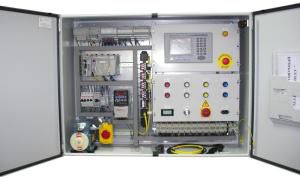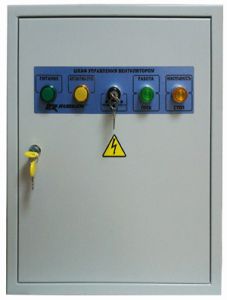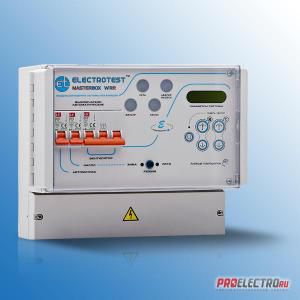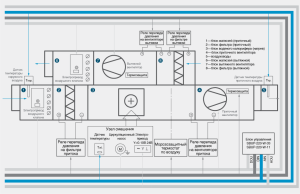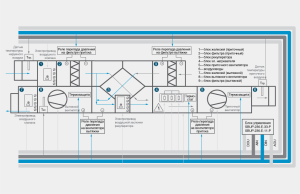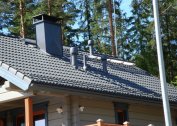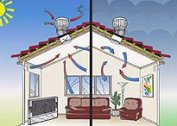Cabinets for ventilation automation are designed for manual or automatic control of modern air exchange systems. They work with almost any type of ventilation equipment, convenient in installation and operation.
Purpose of ventilation control cabinets
A cabinet for controlling ventilation without the participation of personnel provides the necessary temperature and humidity in the premises that meet the requirements, and also increases the safety of the equipment. It allows you to set any supply air indicators and automatically maintain them for the required time.
Automatic ventilation shield suitable for ventilation systems:
- with water heating;
- electric heating;
- heat recovery;
- recirculation;
- smoke control (retaining);
- supply, supply and exhaust and exhaust.
Parameters can be changed using the remote control or computer network. When an accident occurs, the control room immediately receives a signal.
Functions of the automatic ventilation cabinet
Capabilities of ventilation control cabinets:
- maintain the required constant power supply;
- allow you to conveniently connect lines of different power voltage to various terminal blocks;
- they control the rotation rate of the fans, smoothly start them and do not allow phase imbalance;
- equalize power, preventing equipment overheating, overload and short circuits;
- control the voltage in the network autonomously, remotely or locally.
The supply and exhaust ventilation control cabinet operates in standby or summer modes. In summer mode, the air temperature is not controlled. When the supply air temperature is low, the cabinet automation switches the supply ventilation control to protection mode.
Standard features
- Manual stop and start;
- compatible with temperature sensors of supply, external air, and also return heat carrier;
- fixes the temperature of the contacts of the fan motors;
- adjusts the function of the air valve drive;
- prevents short circuits and overloads of the pump motor;
- controls the heat supply valve actuator;
- prevents freezing of water heaters and freon coolers;
- prevents overheating of the electric heater;
- prolongs the stop of the supply air fan;
- gives signals about the need to clean the air filters;
- stops and de-energizes equipment in case of fire alarm;
- notifies with a light indication of the system;
- fixes accidents in a special journal.
Advanced features
-
Prevents pressure drops during breakage of the fan belt;
- Provides frequency conversion for fans;
- Regulates indoor air temperatures in a cascading manner;
- compatible with exhaust temperature sensor;
- notifies of an accident by light indication;
- remote control connection possible;
- controls the operation of the air valve;
- provides connection of additional fans;
- two-phase control of the compressor-condenser unit;
- five-phase control by an electric heater;
- controls the mixing chamber;
- prevents freezing of the recuperator and rotary regenerator;
- controls humidifiers;
- programmed for 7 days;
- controls the cooler valve;
- controls recirculation flaps;
- with insufficient heating power reduces the speed of rotation of the fan blades;
- saves data in memory after a power outage;
- controls the level of carbon dioxide.
By order, manufacturers equip the cabinet for automatic control of ventilation with additional features:
- work without sensors;
- recording reports on the system;
- cold recovery;
- dispatching remote or local control.
Diagram of ventilation control cabinets
A wide selection of control cabinets for supply and exhaust and supply ventilation allows you to choose the best option for any types and combinations of equipment.
The standard layout of the ventilation control cabinet includes:
- frequency converter;
- microprocessor controller;
- starters, circuit breakers;
- circuit breakers;
- contactors;
- protective mechanisms;
- relay;
- indicator lights of the modes.
Frequency converters are necessary to change the speed of rotation of the fan blades and the induction motor, start the mechanisms without jerking, providing a more favorable mode of operation. Frequency control provides speed control in both manual and automatic mode, prevents engine overloads. Reducing energy costs, and increasing system security, extending the life of the system.
One of the important elements of the ventilation cabinet control circuit is the controller.
Controller Types:
- discrete;
- analogue.
Models presented on the Russian market contain a programming menu in Russian. The capabilities of the controller are sufficient to solve any problems that arise during the operation of ventilation systems. The most practical controllers are free programming, which allow you to organize the management of the ventilation system of any circuit.
Reliable and simple design of the ventilation control cabinet allows not to carry out its service and maintenance. Once every 6 months, the integrity of the cables and insulation, the grounding condition are checked. In addition, you must adhere to the rules of operation of the equipment.
The shield is simple and convenient to use, it is made from modern and high-quality materials. Indication is provided by LEDs that burn evenly and brightly.
Rules for the placement of ventilation control cabinets
Ventilation control cabinets are designed for continuous operation, withstand temperatures ranging from -10 ... + 55 degrees Celsius.
Cabinets for supply ventilation control are made in metal or plastic cases.
The closed metal case has a degree of protection IP31, plastic - IP45.
The cabinet for controlling the supply and exhaust ventilation is powered from 220 or 380 Volts with mandatory grounding and a current frequency of 50 Hz in the network.
Supply ventilation control cabinets are mounted only indoors, away from sources of moisture, dust, heat and active chemicals.
It is forbidden to use the ventilation control cabinet in case of high humidity, getting wet, exposure to direct sunlight, radio or magnetic interference.
The optimal place to place the cabinet is the electrical panel or control room.
Control cabinet wiring video:
